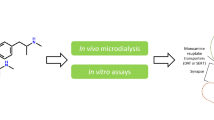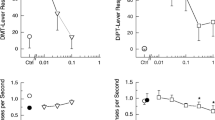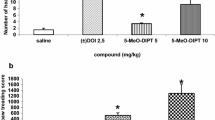Abstract
Paroxetine was shown to be a potent (K i =1.1 nM) and specific inhibitor of [3H]-5-hydroxytryptamine (5-HT) uptake into rat cortical and hypothalamic synaptosomes in vitro. Lineweaver-Burk kinetic analysis determined that this inhibition was competitive in nature, implying a direct interaction with the 5-HT uptake transporter complex. Oral administration of paroxetine produced a dose-related inhibition of [3H]-5-HT uptake (ED 50=1.9 mg/kg) into rat hypothalamic synaptosomes ex vivo with little effect on [3H]-l-noradrenaline (NA) uptake (ED 50>30 mg/kg). This selectivity for 5-HT uptake was maintained after oral dosing for 14 days. Paroxetine (ED 50 1–3 mg/kg PO) prevented the 5-HT depleting effect of p-chloroamphetamine (PCA) in rat brain, demonstrating 5-HT uptake blockade in vivo. Radioligand binding techniques in rat brain in vitro showed that paroxetine has little affinity for α1, α2 or β adrenoceptors, dopamine (D2), 5-HT1, 5-HT2 or histamine (H1) receptors at concentrations below 1000 nM. Paroxetine demonstrated weak affinity for muscarinic receptors (K i =89 nM) but was at least 15 fold weaker than amitriptyline (K i =5.1 nM). Paroxetine, therefore, provides a useful pharmacological tool for investigating 5-HT systems and furthermore should be an antidepressant with reduced tricyclic-like side-effects.
Similar content being viewed by others
References
Battegay R, Hager M, Rauchfleisch U (1985) Double-blind comparative study of paroxetine and amitriptyline in depressed patients of a University Psychiatric Outpatient Clinic (pilot study). Neuropsychobiology 13:31–37
Bennett JP, Snyder SH (1976) Serotonin and lysergic acid diethylamide binding in rat brain membranes: Relationship to postsynaptic serotonin receptors. Mol Pharmacol 12:373–389
Borup C, Meidahl B, Petersen IM, Vangtorp A, le Fevre Honore P (1982) An early clinical phase II evaluation of paroxetine, a new potent and selective 5-HT-uptake inhibitor in patients with depressive illness. Pharmacopsychiatry 15:183–186
Buus Lassen J (1978a) Potent and long-lasting potentiation of two 5-hydroxytryptophan induced effects in mice by three selective 5-HT uptake inhibitors. Eur J Pharmacol 47:351–358
Buus Lassen J (1978b) Influence of the new 5-HT-uptake inhibitor paroxetine on hypermotility in rats produced by p-chloroamphetamine (PCA) and 4,α-dimethyl-m-tyramine (H77/77). Psychopharmacology 57:151–153
Buus Lassen J, Squires RF, Christensen JA, Molander L (1975) Neurochemical and pharmacological studies on a new 5-HT uptake inhibitor FG 4963 with potential antidepressant properties. Psychopharmacologia 42:21–26
Buus Lassen J, Lund J, Sondergaard I (1980) Central and peripheral 5-HT uptake in rats treated chronically with femoxetine, paroxetine and chlorimipramine. Psychopharmacology 68:229–233
Bylund DB, Synder SH (1976) Beta-adrenergic receptor binding in membrane preparations from mammalian brain. Mol Pharmacol 12:568–580
Chang RSL, Tan Tran V, Snyder SH (1978) Histamine H1-receptors in brain labelled with [3H]-mepyramine. Eur J Pharmacol 48:463–464
Cheng YC, Prussoff WH (1973) Relationship between the inhibition constant (Ki) and the concentration of inhibitor which causes 50% inhibition of an enzymatic reaction. Biochem Pharmacol 22:3099–3108
Claassen V, Davies JE, Hertting G, Placheta P (1977) Fluvoxamine, a specific 5-hydroxytryptamine uptake inhibitor. Br J Pharmacol 60:505–516
Claassen V (1983) Review of the animal pharmacology and pharmacokinetics of fluvoxamine. Br J Clin Pharmacol 15:349S–355S
Creese I, Schneider R, Snyder SH (1977) [3H]-spiroperidol labels dopamine receptors in pituitary and brain. Eur J Pharmacol 46:377–381
Fuxe K, Ogren SO, Agnati LF, Andersson K, Eneroth P (1982) Effects of subchronic antidepressant drug treatment on central serotonergic mechanism in the male rat. In: Costa E, Racagni G (eds) Typical and atypical antidepressants: molecular mechanisms. Raven, New York, pp 91–107
Garver DL, Davis JM (1979) Biogenic amine hypothesis of affective disorders. Life Sci 24:383–394
Hall H (1983) Relationships between receptor affinities of different antidepressants and their clinical profiles. In: Gram LF, Uschin E, Dahl SG, Kragh-Sorensen P, Sjoqvist F, Morselli PL (eds) Clinical pharmacology in psychiatry. Macmillan, London Basingstoke, pp 251–267
Hall H, Ogren SO (1984) Effects of antidepressant drugs on histamine-H1 receptors in the brain and in the periphery. Life Sci 34:397–605
Hall H, Sallemark M, Wedel I (1984) Acute effects of atypical antidepressants on various receptors in the rat brain. Acta Pharmacol Toxicol 54:379–384
Hassan SM, Wainscott G, Turner P (1985) A comparison of the effect of paroxetine and amitriptyline on the tyramine pressor response test. Br J Clin Pharmacol 19:705–706
Hyttel J (1977) Neurochemical characterisation of a new potent and selective serotonin uptake inhibitor: Lu 10–171. Psychopharmacology 51:225–233
Hyttel J (1982) Citalopram-pharmacological profile of a specific serotonin uptake inhibitor with antidepressant activity. Prog Neuro Psychopharmacol Biol Psychiatry 6:277–295
Johnson AM, Nelson DR, Thomas DR (1985) Effect of paroxetine and other 5-hydroxytryptamine (5-HT) uptake inhibitors on central monoamine uptake in vitro and ex vivo. Br J Pharmacol 85:221P
Leysen JE, Gommeren W (1986) Drug-Receptor dissociation time, new tool for drug research: receptor binding affinity and drug receptor dissociation profiles of serotonin-S2, dopamine-D2, histamine-H1 antagonists, and opiates. Drug Dev Res 8:119–131
Leysen JE, Niemegeers CJE, Van Neuten JM, Laduron PM (1982) [3H]-Ketanserin (R 41–46B), a selective 3H-ligand for serotonin2 receptor binding sites. Mol Pharmacol 21:301–314
Lingjaerde O (1983) The biochemistry of depression: A survey of monoaminergic, neuroendocrinological and bio-rhythmic disturbances in endogenous depression. Acta Psychiatr Scand [Suppl] 302:36–51
Lund Laursen A, Mikkelsen PL, Rasmussen S, le Fevre Honore P (1985) Paroxetine in the treatment of depression — a randomised comparison with amitriptyline. Acta Psychiatr Scand 71:249–255
Maas JW, Koscis JH, Bowden CL (1982) Pre-treatment neurotransmitter metabolites and response to imipramine or amitriptyline treatment. Psychol Med 12:37–43
Magnusson I, Tonder K, Engbaek F (1982) Paroxetine, a potent and selective long-acting inhibitor of synaptosomal 5-HT uptake in mice. J Neural Transm 55:217–226
Maitre L, Bauman PA, Jaekel J, Waldmeier PC (1982) 5-HT uptake inhibitors: Psychopharmacological and neurobiochemical criteria of selectivity. In: Ho BT, Schoolar JC, Usdin E (eds) Serotonin in biological psychiatry (Advances in biochemical psychopharmacology vol 34). Raven, New York, pp 229–246
Mellerup ET, Plenge P, Engelsoft M (1983) High affinity binding of [3H]-paroxetine and [3H]-imipramine to human platelet membranes. Eur J Pharmacol 96:303–309
Miach PJ, Dausse JP, Cardot A, Meyer P (1980) [3H]-Prazosin binds specifically to ‘alpha1’ adrenoceptors in rat brain. Arch Pharmacol 312:23–26
Nelson DR, Thomas DR, Richards PE, Johnson AM (1984) Lack of interaction of the antidepressant paroxetine with CNS receptors. Proc IUPHAR 9th International Congress of Pharmacology, London 1465P
Perry BD, U'Prichard DC (1981) [3H]-Rauwolscine (alpha-yohimbine): a specific antagonist radioligand for brain alpha2-adrenergic receptors. Eur J Pharmacol 76:461–464
Ross SB, Ogren S, Renyi AL, Westerlund D (1976) (Z)-Dimethyl-amino-1-(4-bromophenyl)-1-(3-pyridyl)prop ene(H102/09), a new selective inhibitor of the neuronal 5-hydroxytryptamine uptake. Acta Pharmacol Toxicol 39:152–166
Snyder SH, Axelrod J, Zweig M (1965) A sensitive and specific fluorescence assay for tissue serotonin. Biochem Pharmacol 14:831–835
U'Prichard DC, Greenberg DA, Snyder SH (1977) Binding characteristics of a radiolabelled agonist and antagonist at central nervous system alpha noradrenergic receptors. Mol Pharmacol 13:454–473
Wong DT, Horng JS, Bymaster FP, Hauser KL, Molloy BB (1974) A selective inhibitor of serotonin uptake: LIlly 110140, 3-(p-trifluoromethyl-phenoxy)-N-methyl-3-phenylpropylamine. Life Sci 15:471–479
Wong DT, Bymaster FP, Reid LR, Threlkeld PG (1983) Fluoxetine and two other serotonin uptake inhibitors without affinity for neuronal receptors. Biochem Pharmacol 32:1287–1293
Yamamura HI, Synder SH (1974) Muscarinic cholinergic binding in rat brain. Proc Natl Acad Sci USA 71:1725–1729
Author information
Authors and Affiliations
Rights and permissions
About this article
Cite this article
Thomas, D.R., Nelson, D.R. & Johnson, A.M. Biochemical effects of the antidepressant paroxetine, a specific 5-hydroxytryptamine uptake inhibitor. Psychopharmacology 93, 193–200 (1987). https://doi.org/10.1007/BF00179933
Received:
Revised:
Issue Date:
DOI: https://doi.org/10.1007/BF00179933




